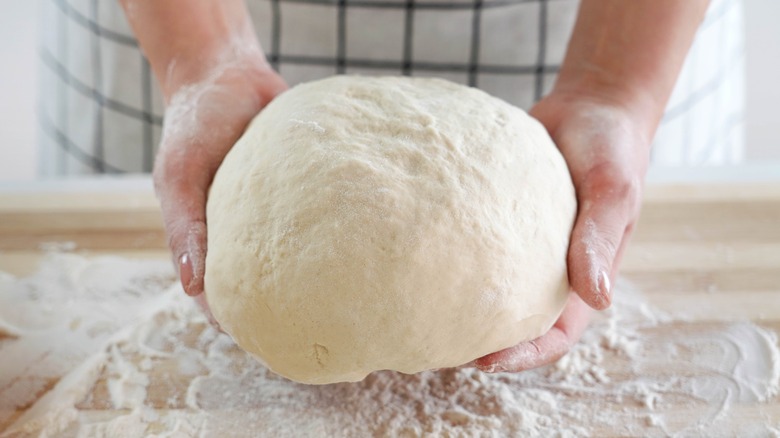The Important Step To Follow When Using Premade Pizza Dough
Making pizza from home can be just as easy as ordering delivery — as long as you follow a few key steps. The extra effort is worth it, however, as making pizza yourself is as fun as it is easy. You can prepare a pie for a casual weeknight dinner or even turn the process into an exciting pizza party. While flashy toppings — pepperoni, brussels sprouts, even pumpkin – tend to get the most attention, the secret to a delivery-worthy pie is actually in the dough.
Depending on how much time you have, there are a few ways you can approach your pizza dough. You can either make the dough from scratch or buy it premade, and both methods have their advantages. With a homemade recipe, you can pull together a hydrated and ultra-thin pie, cheese-stuffed crust, or deep-dish dough. If you prefer to pair your pizza with beer, you can even try combining the two with beer-based pizza dough.
However, as noted by HuffPost, making pizza dough from scratch requires a balancing act of rising times and resting periods. So, for the most impatient of homemade pizza lovers, premade dough may be your best bet. Still, just because you don't have to proof the dough yourself doesn't mean you should rush to get it in the oven. Waiting on your dough, even when store-bought, is a crucial step that is all too easy to skip.
Rest dough at room temperature for easy stretching
Think of preparing your pizza dough like you are getting ready to go jogging. Before you can bring the heat of a full-blown run, you'll want to stretch — and to stretch your best, you'll want to warm up first. According to MasterClass, chilled dough should reach room temperature before you pull and prod it into a pie. Since premade dough is typically refrigerated or frozen prior to usage, leaving the dough on the counter will allow you to stretch and shape it with greater ease. Ideally, you should keep it in an oiled bowl.
About 30 minutes at room temperature should suffice, says The Kitchn. The reason this temperature shift is necessary comes down to the dough's gluten content. Gluten tightens in colder temperatures, so straight from the fridge doughs are less inclined to hold their shape, ultimately snapping back into a tight coil. If you keep your dough at room temperature, however, the dough will loosen up enough to stretch into a pie.
Once your dough reaches room temperature, remember to stretch it out by hand — or give it a toss — instead of rolling it. With a little grunt work, you'll get the best rise and the best slice.

